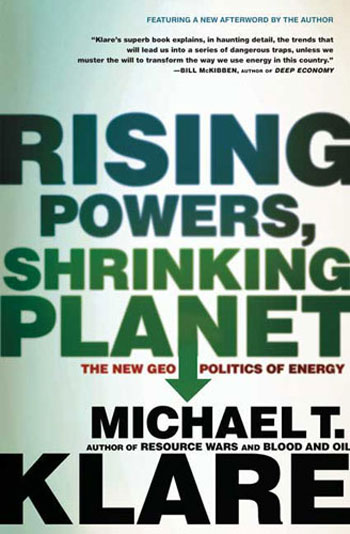A 30-year war for energy pre-eminence? You wouldn’t wish it even on a desperate planet. But that’s where we’re headed.
In the first half of the 1600s, Europe was engulfed in a series of brutal conflicts known collectively as the Thirty Years’ War. In many ways, it was the end of the old rule of emperors and the beginning of the modern system of nation-states across Europe.
 The new war we’re embarking on may not result in as much bloodshed as that of the 1600s, though bloodshed there will be, but it will prove no less momentous for the future of the planet. Over the coming decades, we will be embroiled at a global level in a succeed-or-perish contest among the major forms of energy, the corporations that supply them, and the countries that run on them. In some important ways, Fort Worth is at the center of at least one phase of that coming conflict.
The new war we’re embarking on may not result in as much bloodshed as that of the 1600s, though bloodshed there will be, but it will prove no less momentous for the future of the planet. Over the coming decades, we will be embroiled at a global level in a succeed-or-perish contest among the major forms of energy, the corporations that supply them, and the countries that run on them. In some important ways, Fort Worth is at the center of at least one phase of that coming conflict.
The fight that is being waged in North Texas and places like New York, Pennsylvania, and Colorado over shale gas drilling, its environmental effects, and the resulting effects on the industry’s profitability could be critical in determining the political and economic power that drillers and their political allies will wield. And natural gas — in large part because of shale development — will play a critical part in the energy wars to come.
Worldwide, the question will be: Which energy forms, which corporations, and which countries will dominate energy supplies in the second half of the 21st century? The winners will determine how — and how badly — we live, work, and play in those not-so-distant decades and who will profit enormously as a result. The losers will be cast aside and dismembered.
Why 30 years? Because that’s how long it will take for experimental energy systems like hydrogen power, cellulose-based ethanol, wave power, algae fuel, and advanced nuclear reactors to make it from the laboratory to full-scale industrial development. Some of these systems (along with others not yet on our radar screens) will survive the winnowing process. Some will not. And there is little way to predict how it will go at this stage in the game.
At the same time, the use of existing fuels like oil and coal, which spew carbon dioxide into the atmosphere, is likely to plummet, thanks both to diminished supplies and rising concerns over the growing dangers of carbon emissions.
 This will be a war because the future profitability, or even survival, of many of the world’s most powerful and wealthy corporations will be at risk and because every nation has a potentially life-or-death stake in the contest. For giant oil companies like British Petroleum, Chevron, ExxonMobil, and Royal Dutch Shell, an eventual shift away from petroleum will have massive economic consequences. Such corporations will be forced to adopt new economic models and attempt to corner alternative-energy markets or risk collapse or absorption by more powerful competitors. New companies will arise, some undoubtedly coming to rival the oil giants in wealth and importance.
This will be a war because the future profitability, or even survival, of many of the world’s most powerful and wealthy corporations will be at risk and because every nation has a potentially life-or-death stake in the contest. For giant oil companies like British Petroleum, Chevron, ExxonMobil, and Royal Dutch Shell, an eventual shift away from petroleum will have massive economic consequences. Such corporations will be forced to adopt new economic models and attempt to corner alternative-energy markets or risk collapse or absorption by more powerful competitors. New companies will arise, some undoubtedly coming to rival the oil giants in wealth and importance.
The fate of nations too will be at stake as they place their bets on competing technologies, cling to their existing energy patterns, or compete for global energy sources, markets, and reserves. Because the acquisition of adequate supplies of energy is absolutely critical to national security, struggles over vital resources — oil and natural gas now, perhaps lithium or nickel (for electric-powered vehicles) in the future — will trigger armed violence.
When these three decades are over, the planet is likely to have in place the foundations of a new system for organizing itself, this time around energy needs.
“Going green” will change from a nice-sounding alternative to part of what every country must do to survive. And energy efficiency — in transportation, building design, heating and cooling, and manufacturing techniques — will be crucial in coming decades, at levels far beyond those of today. The lead players three decades from now may be the countries and corporations that have mastered the art of producing the most with the least.
In the meantime, the struggle for energy resources is guaranteed to grow ever more intense for a simple reason: There is no way the existing energy system can satisfy the world’s future requirements. It must be replaced or supplemented in a major way by a renewable alternative system. If that doesn’t happen, a long and bloody war will be only the beginning of our problems. The planet will be subject to environmental disaster of a sort that’s hard to imagine today.
To appreciate the nature of our predicament, begin with a quick look at the world’s existing energy portfolio. According to BP, in 2010 an estimated 33.6 percent of the world’s energy was supplied by oil, 29.6 percent by coal, 23.8 percent by natural gas, 6.5 percent by hydroelectricity, 5.2 percent by nuclear energy, and a mere 1.3 percent by all renewable forms of energy. Together, fossil fuels — oil, coal, and natural gas — supplied 87 percent of the total.
Even trying to preserve this level of energy output over the course of 30 years, using the same proportion of fuels, would be a near-hopeless feat. Achieving a 40 percent increase in energy output — as most analysts believe will be needed to satisfy the existing requirements of older industrial powers and rising demand in China and other rapidly developing nations — is impossible.
There are two major barriers to simply continuing the world’s fuel-use patterns: eventual oil scarcity and global climate change. Most energy analysts expect conventional oil output — that is, liquid oil derived from wells on land and in shallow coastal waters — to reach a production peak in the next few years and then begin an irreversible decline. Some additional fuel will be provided in the form of “unconventional” oil — that is, liquids derived from the costly, hazardous, and ecologically unsafe extraction processes involved in producing tar sands, shale oil, and deep-offshore oil — but this will only postpone the inevitable, not avert it. By 2041, oil will be far less abundant than it is today and won’t come close to meeting its current one-third share of the world’s energy needs.
Meanwhile, the accelerating pace of climate change will produce ever more damage — intense storm activity, rising sea levels, prolonged droughts, lethal heat waves, massive forest fires, and so on — finally forcing reluctant politicians to take remedial action. This will undoubtedly include new limits on the release of greenhouse gases created by fossil fuel use. By 2041, these increasingly restrictive curbs will help ensure that fossil fuels will not be supplying anywhere near 87 percent of world energy.
 What will replace oil and coal as the world’s paramount source of energy? Many industry and political leaders are betting on natural gas.
What will replace oil and coal as the world’s paramount source of energy? Many industry and political leaders are betting on natural gas.
The experts are looking to natural gas to ease the world’s withdrawal pains from oil and coal because natural gas releases less carbon dioxide and other greenhouse gases than other fossil fuels. In addition, global supplies of natural gas are far greater than previously believed, thanks to new technologies — notably horizontal drilling and the controversial procedure of hydraulic fracturing (“fracking”) — that allow for the exploitation of shale gas reserves once considered inaccessible.
The U.S. Department of Energy predicted earlier this year that by 2035 gas would far outpace coal as a source of American energy, though oil would still outpace them both. Some now speak of a “natural gas revolution” that will see it overtake oil as the world’s number-one fuel, at least for a time.
But fracking, as North Texans now know firsthand, poses so many threats to the safety of drinking water and is arousing such widespread opposition that the economics of shale gas may, in the end, prove less attractive than currently assumed. In fact, some analysts now believe that the prospects for shale gas have been oversold and that stepped-up investment will result in ever-diminishing returns.
Prior to the March 11 earthquake and tsunami disaster and the resulting core meltdowns at the Fukushima Daiichi nuclear power complex in Japan, nuclear power appeared headed toward a renaissance involving construction of hundreds of new nuclear reactors over the next few decades. Although some of these plants in China and elsewhere are still likely to be built, plans for those in several other countries already appear to have been scrapped.
In North Texas, Luminant, with most of its regulatory hurdles already cleared thanks to a streamlined approval process, says it is going forward with plans to add two more units at its Comanche Peak nuclear plant near Glen Rose. However, before the disasters in Japan, Luminant had already announced an 18-month delay, because the Nuclear Regulatory Commission ordered a new seismic analysis of the Mitsubishi reactors’ design.
Despite repeated assurances that U.S. nuclear reactors are completely safe, serious safety risks at many of those facilities have been uncovered recently. And of course, the recent New Mexico wildfires that threatened plutonium supplies at Los Alamos National Laboratory and the floods still causing problems for a nuclear plant in Nebraska have added to those questions. Given rising public concern over the risk of catastrophic accident, it is unlikely that nuclear power will be one of the big winners in 2041.
However, nuclear enthusiasts (including President Obama) are championing the manufacture of small “modular” reactors that, according to their boosters, could be built at far lower cost than current ones and would produce significantly lower levels of radioactive waste. Although the technology for (and safety of) such “assembly-line” reactors has yet to be demonstrated, advocates claim that they would provide an attractive alternative to both large conventional reactors with their piles of nuclear waste and coal-fired power plants that emit so much carbon dioxide.
When people start talking about “alternative energy,” the assumption usually is that wind and solar power are at the top of the list. And there’s no doubt that the world will rely on those renewable sources for a greater proportion of its energy 30 years from now. (Texas, the leading wind power state in this country, already gets about 8 percent of its power from wind turbines, mostly in West Texas and along the coast, according to the Texas Tribune.) The International Energy Agency predicts that wind and solar power’s share of world energy consumption will quadruple by 2035. Problem is, that only increases their share from 1 percent to 4 percent of the total — very small potatoes in the face of the current crisis.
For wind and solar to claim a significantly larger share of the energy pie, as so many climate-change activists desire, real breakthroughs will be needed, including major improvements in the design of wind turbines and solar collectors, improved energy storage (so that power collected during sunny or windy periods can be better used at night or in calm weather), and a far more efficient and expansive electrical grid (so that energy from areas favored by sun and wind can be effectively distributed elsewhere). China, Germany, and Spain have been making the sorts of investments in wind and solar energy that might give them an advantage in the new Thirty Years’ War — but only if technological breakthroughs arrive.
Like wind and solar, corn and algae also have a long way to go before they can move to the front ranks of contenders. But many experts see a promising future for biofuels, especially as “first-generation” ethanol, based largely on the fermentation of corn and sugar cane, is replaced by second- and third-generation fuels derived from plant cellulose and bio-engineered algae.
Aside from the fact that the fermentation process requires heat (and so consumes energy even while releasing it), many policymakers object to using food crops to make motor fuel at a time of rising food prices and likely future food shortages. However, production of ethanol by chemical means from the cellulose in non-food crops is now being tested, and one of these techniques may well survive the transition to full-scale commercial production.
 A number of companies, including ExxonMobil, are exploring the development of new breeds of algae that reproduce swiftly and can be converted into biofuels. (The U.S. Department of Defense is also investing in some of these experimental methods with an eye toward transforming the American military, a great fossil-fuel guzzler, into a far “greener” outfit.)
A number of companies, including ExxonMobil, are exploring the development of new breeds of algae that reproduce swiftly and can be converted into biofuels. (The U.S. Department of Defense is also investing in some of these experimental methods with an eye toward transforming the American military, a great fossil-fuel guzzler, into a far “greener” outfit.)
Then there’s hydrogen, which many experts were talking about a decade ago as holding immense promise as a source of energy. Hydrogen is abundant in many natural substances (including water and natural gas) and produces no carbon emissions when consumed. But extracting it requires significant amounts of energy and so remains not particularly efficient. Methods for transporting, storing, and consuming hydrogen on a large scale have also proved harder to develop than once imagined. It appears unlikely that hydrogen will prove a major source of energy by 2041.
Other possible solutions to the energy enigma have advanced to the pilot project stage. Among the most promising are geothermal energy, wave energy, and tidal energy. Each taps into immense natural forces and so, if the necessary breakthroughs were to occur, would have the advantage of being infinitely exploitable, with little risk of producing greenhouse gases. However, the necessary technologies are still at an early stage of development, except for geothermal. And geothermal energy has its own problems, given the need to tap it by drilling deep into the earth, in some cases triggering small earthquakes.
Three decades from now, for better or worse, the world will be a far different place: hotter, stormier, with less land (given the loss of shoreline and low-lying areas to rising sea levels), and probably having weathered years of violence and instability. Strict limitations on carbon emissions will certainly be universally enforced and the consumption of fossil fuels, except under controlled circumstances, actively discouraged. Oil will still be available to those who can afford it but will no longer be the world’s paramount fuel. New powers, corporate and otherwise, in new combinations will have risen with a new energy universe.
I might place my bet on energy systems that have been decentralized, are easy to make and install, and that require relatively modest levels of up-front investment. For an analogy, think of the laptop computer of 2011 versus the giant mainframes of the 1960s and 1970s. The closer an energy supplier gets to the laptop model, I suspect, the more success will follow.
From this perspective, giant nuclear reactors and coal-fired plants are, in the long run, less likely to thrive, except in places like China where authoritarian governments still call the shots. Far more promising, once the necessary breakthroughs come, will be renewable sources of energy and advanced biofuels that can be produced on a smaller scale with less up-front investment and so possibly incorporated into daily life even at a community or neighborhood level.
No one can know, of course, what new forms of energy will have been developed or who the winners and losers will be. But the countries that move most quickly to embrace new energy possibilities will be the likeliest to emerge in 2041 with vibrant economies — and given the state of the planet, if luck holds, just in the nick of time.
A version of this story first appeared on the online news site TomDispatch.com.











